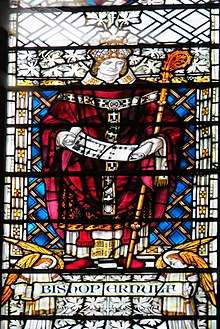Ernulf
Ernulf (1040– 15 March 1124) was a French Benedictine monk who became prior of Christ Church in Canterbury, abbot of Peterborough, and bishop of Rochester in England. A jurist and an architect as well, he was responsible for greatly expanding Canterbury Cathedral during his time there.
- For the given name Ernulf, Earnulf, see Arnulf.
Ernulf | |
|---|---|
| Bishop of Rochester | |
 | |
| Appointed | 28 September 1114 |
| Term ended | 15 March 1124 |
| Predecessor | Ralph d'Escures |
| Successor | John |
| Other posts | Prior of Christ Church, Canterbury Abbot of Peterborough |
| Orders | |
| Consecration | 26 December 1115 |
| Personal details | |
| Born | 1040 Beauvais |
| Died | 15 March 1124 |
| Denomination | Catholic |
Life
Ernulf studied under Lanfranc at the monastery of Bec, entered the Benedictine Order, and lived at the monastery of St-Lucien, Beauvais. At the suggestion of Lanfranc, he went to England some time after 1070 and joined the monks of Canterbury.[1] He studied under Ivo of Chartres and was considered an expert on canon law.[2]
Ernulf was made prior by Archbishop Anselm in 1096 and began the expansion of Lanfranc's rebuilt Canterbury Cathedral, taking down the eastern part of the church which Lanfranc had built and erecting a far more magnificent structure. This included the famous crypt (Our Lady of the Undercroft), as far as Trinity Tower. The chancel was finished by his successor Conrad. The chapel of St. Andrew is also part of Ernulf's work. In 1107, he was made Abbot of Peterborough,[1] where he was one of the teachers of Hugh Candidus.[3] On 28 September 1114, he was invested as bishop of Rochester by Ralph d'Escures, the archbishop of Canterbury.[4] He was consecrated on 26 December 1115.[5] At Peterborough and Rochester, Ernulf had the old buildings torn down and erected new dormitories, refectories, chapter houses, etc.
Ernulf is associated with the production of the Textus Roffensis (a large collection of documents relating to the early Church of Rochester which also included the early Kentish law code attributed to King Aethelberht); "Collectanea de rebus eccl. Ruffensis".[2][6] The collection reflects his interest in and sympathy towards pre-Conquest traditions apparent elsewhere. Aspects of Anglo-Saxon liturgical practice were revived at Canterbury and he may also have influenced the restoration of the shrines and altars to Anglo-Saxon saints to their former prominence during the development of the Cathedral. His abbacy at Peterborough additionally seems to have coincided with renewed interest in the Anglo-Saxon Chronicle there.[7] He also authored several canonical and theological treatises.
Ernulf died on 15 March 1124.[5]
Citations
- British History Online Priors of Canterbury accessed on 30 October 2007
- Williams English and the Norman Conquest p. 156
- Dictionary of National Biography :Hugh Candidus. Oxford University Press. 1885–1900. Retrieved 8 August 2010.
- British History Online Bishops of Rochester Archived 14 February 2012 at the Wayback Machine accessed on 30 October 2007
- Fryde, et al. Handbook of British Chronology p. 267
- In Patrologia Latina, CLXIII, 1443 sqq.
- R.W. Southern, St Anselm: A Portrait in a Landscape (Cambridge, 1993 edn.), pp. 322-3
References
- British History Online Bishops of Rochester accessed on 30 October 2007
- British History Online Priors of Canterbury accessed on 30 October 2007
- "Ernulf". Catholic Encyclopedia. Retrieved 18 February 2007., source
- Fryde, E. B.; Greenway, D. E.; Porter, S.; Roy, I. (1996). Handbook of British Chronology (Third revised ed.). Cambridge: Cambridge University Press. ISBN 0-521-56350-X.
- Williams, Ann (2000). The English and the Norman Conquest. Ipswich: Boydell Press. ISBN 0-85115-708-4.
| Catholic Church titles | ||
|---|---|---|
| Preceded by Ralph d'Escures |
Bishop of Rochester 1114–1124 |
Succeeded by John |
![]()